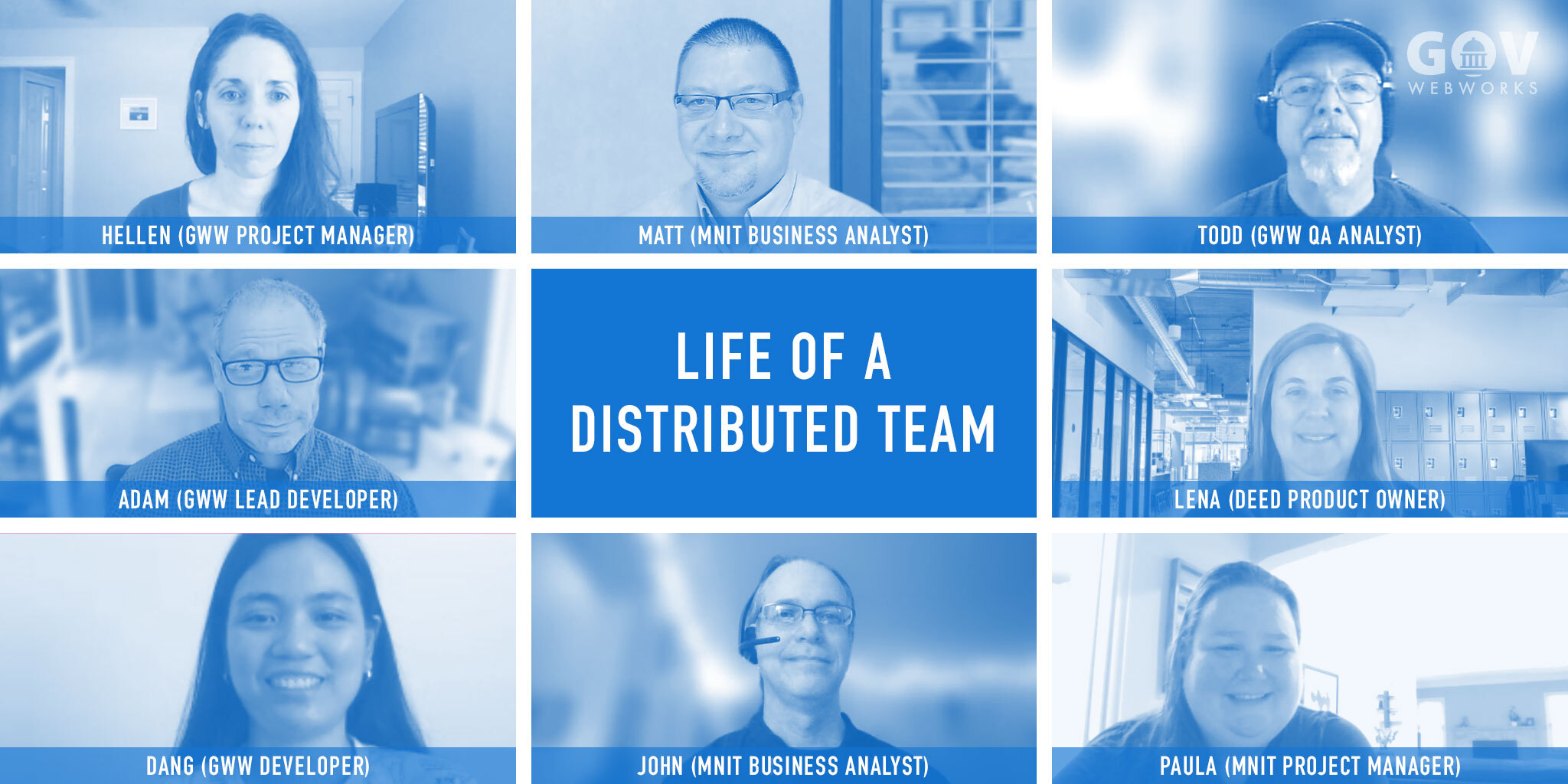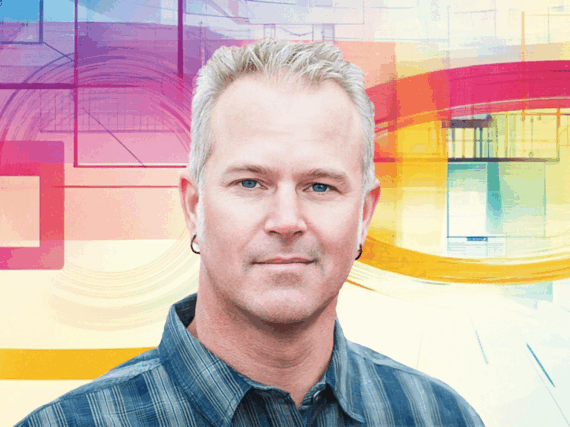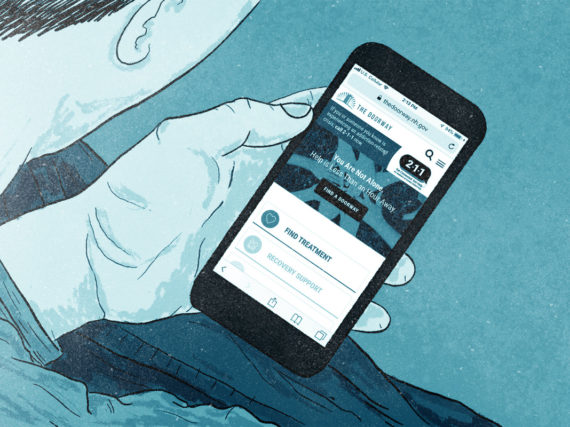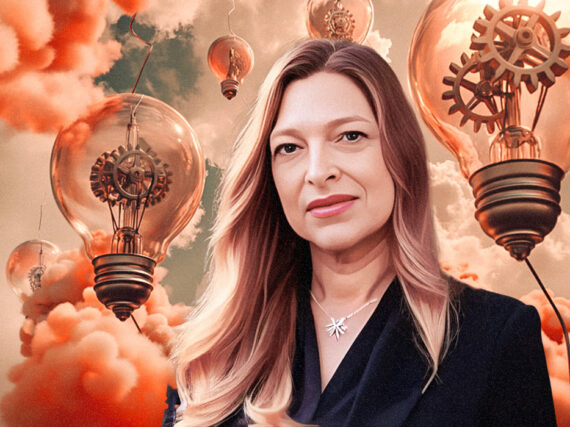Hi, we’re Team MN DEED BOT.
We’re a software development team with distributed members in Maine, Minnesota, and one in Texas. As MN DEED BOT, we’ve worked “remotely together” for more than a year, with many of us collaborating to develop CareerForceMN.com prior to that. Some of us work for Minnesota’s Department of Employment and Economic Development (DEED) and Minnesota IT Services (MNIT), and the rest with GovWebworks (GWW), the vendor.
We’ve recently launched a chatbot, the CareerForceMN Assistant, on the CareerForce website. This new virtual assistant directs job seekers to specific programs that can help them find jobs and build stable careers. In the interest of transparency and continuous improvement, we thought we’d share a snapshot of the team process that helped our distributed team meet project goals.
Teams often follow a sequence of phases as they develop and evolve to deliver strong results, according to psychologist Bruce Tuckman. The forming-storming-norming-performing model of team development is a useful framework by which to view our team’s evolution on the MN DEED BOT project. Since our team was already distributed between Maine, Minnesota, and Texas, the shift to working from home during the pandemic was a fairly smooth one. Ultimately, we identified that team communication and the Agile/Scrum process is as essential to working remotely as it is for a successful project launch. Here’s why.
Forming
During the forming phase, a team defines working agreements that reflect group goals in the effort to optimize working together.
Define common ground
From the start of the GWW and DEED partnership, we’ve emphasized our common ground. Mainers and Minnesotans share a lot of similarities, and this helped us to feel comfortable with each other and build trust as a team.
- Hellen (GWW Project Manager): “When we kicked off the project, the original DEED team gave us candy gift bags and a poem comparing Maine to Minnesota, with all the reasons why they thought we are a good fit to work together. The DEED team jokes about being ‘Minnesota nice,’ but they are in fact truly nice people who know that we are all human and everyone is trying their best. The good humor and camaraderie have persisted throughout the partnership and the current DEED team continues to be engaged in all aspects of the CareerForceMN.com platform and the DEED BOT project.”
- Paula (MNIT Project Manager): “I feel lucky to be working on a team that has the knowledge, skills, and abilities that this team has. As a PM it’s important to get to know the team, and encourage team members to openly communicate so that issues or concerns can be addressed as early as possible.”
Define scrum principles
We follow a Scrum schedule of iterative deliveries selected from the backlog for two-week sprints. This means we continuously plan, do, review/test, and deploy during each sprint until the backlog of stories (deliverables) for the project is complete.
- Todd (Quality Assurance Analyst, backup PM): “Agile/Scrum is vital to our success here on the DEED team. Thankfully, it’s part of the team DNA, established right from the beginning.”
- John (MNIT Business Analyst): “Agile/Scrum truly defines this team’s working methods. We make changes on the fly in support of technical and business needs. The regular presence of product owner and SMEs from the business helps us get timely decisions and authorizations for changes.”
- Hellen: “Agile/Scrum is critically important to our work, as is continued communication, and refinement based on feedback that helps to deliver a better outcome.”
Define project stages
Our project included five stages, which were tackled in two-week sprints (Define, Design, Prototype, Build, Launch). We managed our project backlog with a program called Jira so the whole team can track task completion and burn rates in real time.
- Todd: “The most useful tools vary from team member to team member, but Jira ranks up there by everyone as a useful tool.”
- Matt (MNIT Business Analyst): “When we started putting MNIT stories in Jira it was great to be able to show our work alongside that of GWW.”
Define meeting needs
Scum recommends five team check ins during a sprint. (For more about Scrum meetings, see our blog on How to Get the Most Out of Scrum Meetings.) Our team agreed to condense three of the five meetings to result in the following meetings for each sprint:
1. Sprint Retro / Backlog Grooming / Planning
Naturally, each sprint begins at the end of the previous sprint, so we combined the Sprint Retro with Backlog Grooming and Planning for the next sprint.
- Retro reviews the activities of the past sprint for feedback and suggestions for improvement
- Backlog Grooming gets the backlog stories in shape by clarifying any questions about scope or difficulty
- Planning sets up goals and deliverables for the next sprint and selects the appropriate stories from the backlog
These three meetings (now combined by our team) are the core of Scrum.
- Todd: “I believe that all of the meetings associated with the sprint cycle are incredibly useful on many levels. If I had to choose a meeting that is least useful, it would be the Sprint Retrospective. The team is working so well together that we rarely have any useful outcomes (good or bad) that can be built upon from having a retrospective. So, sometimes it does feel like we are simply ‘going through the motions,’ but if you don’t row the row boat, you may never get to your destination!”
2. Standup
Standup meetings occur every day on video at 10:30am EST. Though we don’t stand up for the video meeting like we do in person, we still try to keep it short and to the point, as intended. We typically review what is in progress and what is left to do in the Jira swim lanes. Those that are contributing to a story share past, present, and future goals. We also discuss any production-related issues the team needs to be aware of. Roadblocks can be identified and removed as a team and any longer discussions are moved to the parking lot for a more detailed meeting, if needed.
- Paula: “Standups provide us with the ability to address issues as they come up.”
- Todd: “Our daily morning Standups keep me connected.”
- Matt: “Standups have been great resolvers and collaboration time. Video conferencing has worked great for Standups and collaboration in real time.”
- Lena (DEED Product Owner): “The daily Standups using Microsoft Teams/Zoom to review progress are most important to me.”
3. Sprint Demo
Also called the Sprint Review, the Demo is when we show off the work of the sprint to make sure it delivers what the stakeholders were expecting. It also gives everyone a chance to stay up to date on progress and provide feedback before something is deployed.
- Paula: “Demos provide an opportunity to capture feedback from stakeholders, partners, and subject matter experts who might not be as involved in day-to-day development.”
- Matt: “Demos are useful to get feedback from business.”
Storming
The storming phase can sometimes be difficult for a team as each member jockeys to find the right position. This is when boundaries can be pushed, trust gained (or not), and individual styles learned. It is also when the organization of the team is clarified and defined. We did much of our storming with the initial launch of CareerForceMN.com, so it was relatively painless for MN DEED BOT.
- John: “We have two project managers, one for GWW and one for MNIT. The developers are almost exclusively on the GWW team, so Hellen performs the essential role of keeping GWW’s developers, designers, and QA coordinated and rolling through or around any impediments. On the MNIT side, Paula performs the essential role of ensuring a steady stream of business requirements and decision flows from the DEED product owners and SMEs via the MNIT Business Analysts to GWW.”
- Hellen: “PMs have a weekly meeting to discuss active and upcoming work, ensuring alignment and a focus on top priorities. Communication of those priorities are shared amongst team members at Scrum meetings, in Jira, Slack, email, and/or InVision. Team members collaboratively review the sprint backlog at each Standup and Sprint Planning to ensure understanding of work and conditions of satisfaction.”
- Todd: “Keeping it personal seems to make everyone feel comfortable. Comfort often leads to increased participation, especially in remote settings. Invariably, we’ll strike up a conversation in any of the meetings, asking what everyone is doing for the upcoming weekend, or how a recent vacation went.”
Norming
As we developed as a team, we began to find our norms, which meant we were able to accept each other and our roles and work together to achieve project goals. It helps that we agree on the following ground rules:
- Treat each member as an individual
- Empower members to manage and create
- Seek feedback from team members
To make communication between team members as easy as possible and value the input of all team members and stakeholders, we also encourage the following goals:
- Foster online communication channels
- Elicit stakeholder involvement
- Value the collaborative nature of design
The PMs are key in reinforcing these values during the course of the project.
- Todd: “Both the PMs offer ample reminders for folks to speak up if there are questions or comments.”
- Hellen: “We try to allow time during meetings to have team chit-chat and for open dialog in Slack channels including humor and personal happenings/achievements.”
- John: “A good team relationship is built through the working relationships, and some amount of casual conversation and humor will naturally flow from that in meetings. When a PM plans fun activities, it makes me think the PM has not done the job of building good working relationships. Fortunately for this team, we find conversation and humor together without even having to try.”
- Lena: “This team has been great to work with, making everyone feel comfortable and inclusive so people want to contribute as necessary.”
To foster collaboration, our primary team communication channels include:
- Video meetings on Microsoft Teams
- Slack for group and direct messaging, as well as phone and video chats
- Email and phone if all else fails
Everyone has their preferred channel, but we find the combination of all channels takes the place of most in-person interactions.
- Matt: “Slack has been amazing for questions and asynchronous conversations and is heavily used, even by our business partners. It helps keep the team moving if one member is out or unavailable.”
- Todd: “There have been several occasions where a one-on-one video call with a fellow team member helps me feel the most connected. Interestingly, I find that email is rarely used. When it is used, it’s primarily for communicating with stakeholders that are not members of the project team.”
- John: “Video meetings give me the strongest sense of human connection and relationship with team members. But Slack is the best way to share critical information quickly back and forth with GWW.”
- Paula: “The best communication method depends on the message and with whom I’m communicating. I try and take preferences into account, where I can.”
Performing
For the development and launch of the chatbot, the performing phase was where our team became adept at making decisions without supervision, though the PMs were always part of the collaboration. Differences of opinion were resolved through discussions to reach the best end, and new team members were able to integrate into the work fairly easily.
- John: “When team members leave, it’s been important for team cohesion that the PMs and other team members acknowledge to each other the value that the departed team member delivered. This builds a culture of mutual respect and appreciation.”
- Todd: “The PMs usually take steps to pair an existing team member with the person who is leaving the team in order to learn and take on any important responsibilities that need to be transitioned.”
By the time we successfully launched the chatbot, we’d realized we’d also found our groove with everyone working remotely.
- Hellen: “Whether you’re in person or remote, team communication is key. The work that we do can successfully be achieved remotely. While the transition to everything being remote had its challenges at first, once we found an established rhythm, it has been great.”
- Sarah (TAA Support/advocate): “Working remotely works for us because our team already developed relationships in-person before the pandemic. If I were starting over in a job/employer, I think I’d prefer working in-person at least some of the time. Relationships are hard to develop 100% remotely. I do miss the natural conversations that happen in passing (in the lunch room, halls), and hearing laughter.”
- Dang (GWW Developer): “I would be happy to continue working remotely indefinitely. I think we manage our projects effectively and all team members engage in solving problems.”
- Tamika (DEED/TAA Senior Specialist/TAA Project Lead): “I feel that our DEED team works very efficiently remotely and we are able to adhere to deadlines while providing excellent service to our customers and internal and external partners. The remote work with GWW on this chatbot project has gone very smoothly.”
In summary
We’re proud as a team to have delivered a chatbot that provides additional support for building the workforce in Minnesota.
For more about the actual development of the CareerForceMN Assistant, and how it works, stay tuned for another post by lead developer Adam Kempler on how we did it.
Learn more
- Contact us to learn more about adding a chatbot to an agency website
- CareerForceMN Improves Access to Employment Resources: Chatbot connects Minnesota employers and job seekers with the content they need to fill and find jobs, 2021
- Putting Together the Labor Force Puzzle: How Minnesota’s new CareerForce site encourages workforce growth, 2019
- All In a Day’s Work: How Minnesota is encouraging labor force participation with help from the Workforce Innovation Fund, 2018
- CareerForce Workforce Development Portal: GovWebworks Case Study







